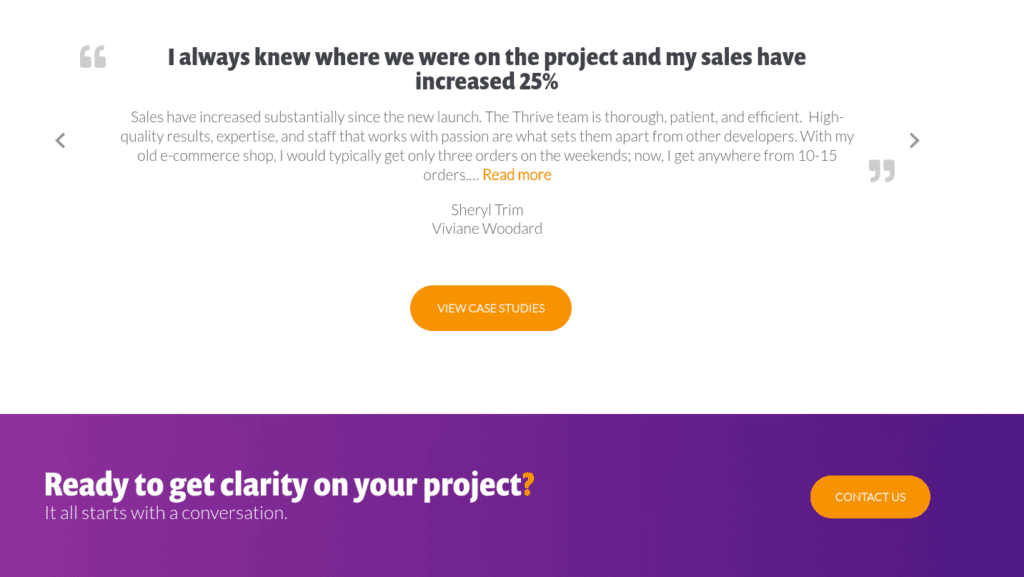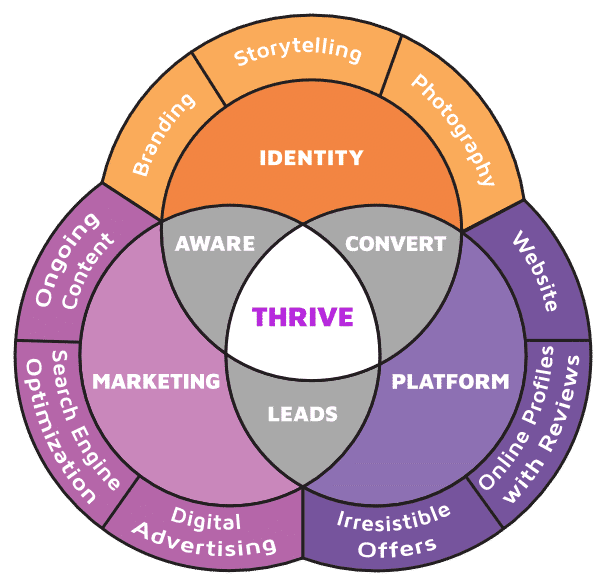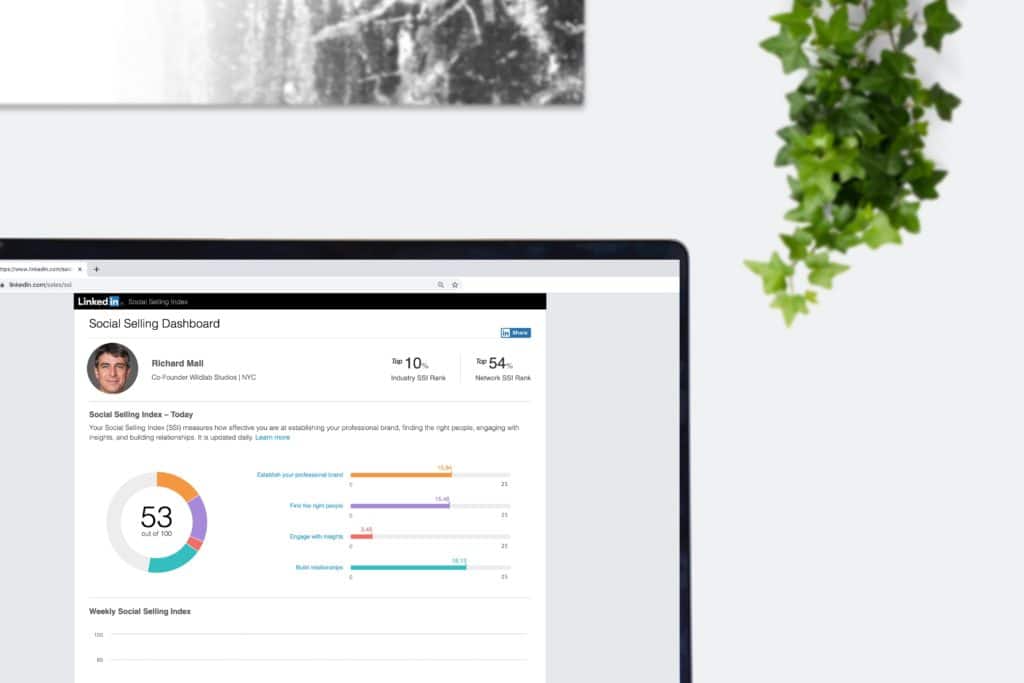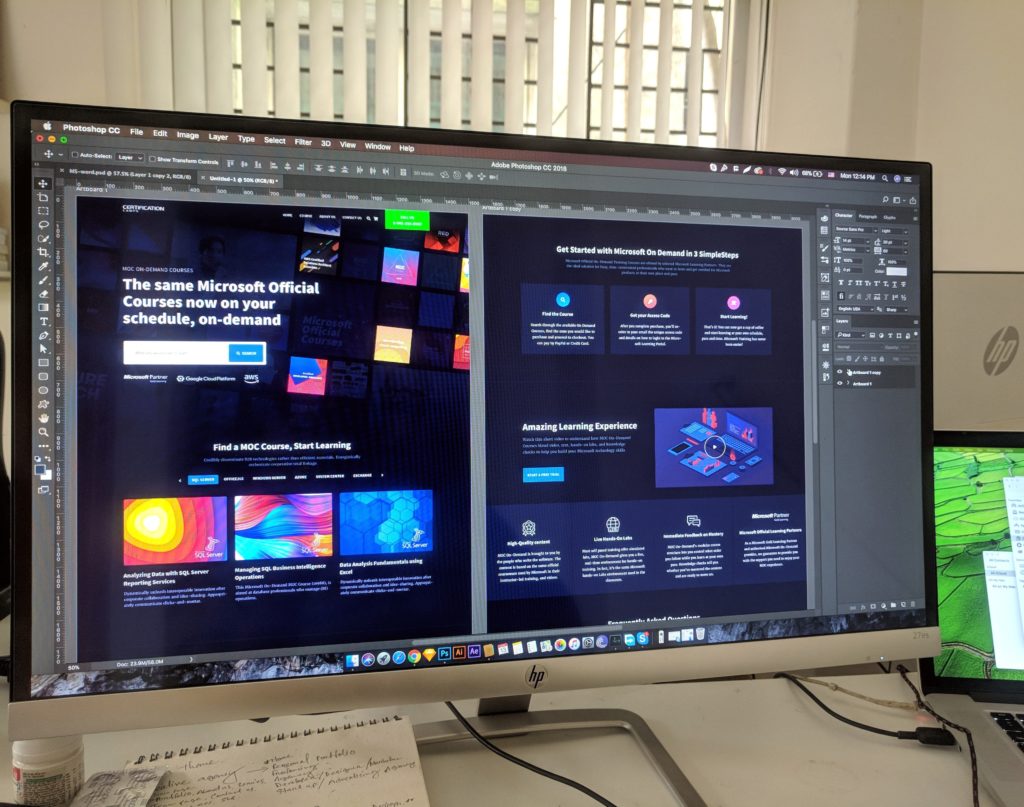The need for businesses to deliver engaging communications to their audiences has become principal in the age of digital marketing. Audiences are more distracted than ever, with display ads and pop-ups occupying the majority of our online environment. So how do we cut through the clutter? The answer is personalized and targeted email marketing.

Email marketing is the digital process of communicating with audiences via direct email. It’s an effective tool in engaging with customers on topics of interest, to drive sales and strengthen brand relationships.
The days of mass mailing have swiftly been replaced by consensual and personalized emails throughout the customer journey. Whether it be newsletters, shopping cart reminders, or sale secrets, email marketing has all bases covered.
They generally fall into one of three categories; promotional, informational, or buyer journey focussed. Promotional emails focus on special offers or product releases, whereas informational emails may take the form of more copy-heavy announcements or newsletters.

Unlike other forms of digital marketing, the beauty of email is that audiences actually choose to opt-in for receiving your commercial content. This means that your audience is voluntarily entering their email address into your sign-up list, whether it be via your website, social media, landing pages, or elsewhere. Brands frequently offer a welcome voucher or incentive to encourage this, however loyal customers might simply subscribe without!

Email marketing remains the most profitable direct marketing channel, generating a huge return on investment (ROI) of $42 for every $1 spent. Combining this with a low cost and high conversion rate, it’s obvious why many businesses are choosing such a profitable communication channel.
Unlike many marketing channels, email utilizes opt-in audiences that you know are interested in your brand and what you have to offer. This makes the approach much more targeted as opposed to mass-marketed campaigns.
Most of this process can be streamlined to suit your commercial email needs, taking the hassle out of digital marketing. Autoresponders can be utilized for sending automatic and personalized emails to prospective customers at each stage of their journey.
Email Marketing offers the ability to consistently monitor and evaluate your campaign results. Regularly assess your campaign against KPI’s and marketing metrics, to optimize your content and make the most of your digital strategy.

Email marketing is a streamlined process but it’s important you have the right tools before jumping straight in. We recommend starting with an email service provider (ESP). Also known as an email marketing platform or tool, an ESP is essentially software designed to send and manage email campaigns so you don’t have to. This avoids formatting and other HTML or web-based issues that you may otherwise run into.
As mentioned earlier, email marketing is an opt-in process which means you’ll have to source your own email list. We’d recommend visibly displaying this option across your brand channels, ideally with some sort of welcome incentive. From here, your email list can be segmented into customer categories, to deliver more personalized and targeted results.
It’s important that your emails stand out when they arrive in an inbox. Aim for an intriguing subject line, with internal copy that you know is relevant and topical to your target audience. Include images where relevant and ensure your formatting is responsive for any user platform. (Hint: pre-made templates are great for this).
Now that you’ve developed your content, it’s time to perfect your work. It’s important to make the most of your subject header and email sender name, after all this text is what will draw in your audience to actually open your emails. We’re aiming for open rates, clicks, and conversions.

The final step of email marketing is to monitor and evaluate your campaign’s success rates. The good news is, this is relatively easy to do with the help of an email service provider. We’d recommend using A/B testing to determine what type of emails are best suited to your audience. This will involve monitoring metrics such as new subscribers, open and click-through rates, and ultimately your conversion rates.
Email marketing is an effective tool in converting prospective customers to loyal brand advocates. With these tips and tricks, you’ll be well on your way to marketing your business like an expert. Get in touch with us here at Thrive Design to start your digital marketing journey.
It’s one of the most common questions we’re asked about digital marketing: what’s the difference between SEO and PPC? The translation of these acronyms is not common knowledge for someone outside the industry. However, if you are branching out into the online marketing sphere to grow your business, it’s important to know that different pathways are available, each with its own benefits and risks.
SEO and PPC are two forms of digital marketing with some significant differences, and if you’re considering either, it’s vital that you understand which will best suit your needs.
This blog is a beginner’s guide to SEO and PPC, outlining the pros and cons of each. If you’re ready to start crafting a tailored digital marketing plan for your company, reach out to Thrive Design today for some personalized advice.
When you search up anything on Google, you’re brought to the Search Engine Results Page (SERP). Here’s where you find all the recommended websites, blogs, and businesses that best match what you’ve searched – however, at the very top of the search page, you may notice a few links marked as Ads. This is PPC in action, which stands for Pay Per Click. And on a Google SERP, this is called Google Ads.
Google Ads is a form of PPC because you pay for each time a searcher clicks on your Ad. Instead of navigating the algorithms and ranking systems of search engines, you’re able to give your business the benefit of skipping the competitive organic rankings, and you simply pay for all the clicks you receive in return.
The term ‘PPC’ also covers other digital ads where clicks are paid, including sponsored social media ads on Facebook or Instagram or pop-ups on similar websites.
The cost you pay per click (CPC= cost-per-click) on Google Ads is determined by an auction-style process. The more competitive a keyword is, the more you’ll have to pay. Why? Because there are only limited spots available, and not everyone can be on top!
The cost of a keyword depends on various factors, such as its search volume (how many users are searching for that keyword on Google each month) and competition. As of January 2021, these were the top three most expensive keywords on Google Ads in the US:
But don’t let these prices scare you! Because the average CPC in 2021 ranged from $1 to $2. This is why professional Google Ads management is so important. If you structure your campaign poorly, you could spend your budget very quickly without a very high return on investment. A Google Ads specialist will ensure you have correctly set up your campaign to maximize performance and return on your investment, so you spend less and get more!
The greatest perk of PPC is that you will see results with a lightning-fast turnaround. You could sign up for Google Ads today and see your business listed in a matter of a couple of hours! Plus, PPC is a sure-fire way to ensure that your website will list right at the top of the SERP – giving you the quickest chance to catch a potential customer’s eye. If you’re looking to see your site jump to the top of the search results immediately, PPC is the way to go.
Here’s the downside: PPC is exactly what it says on the tin. While arguably less complicated than SEO marketing, it is the more expensive option as it requires continual financial input to generate results. Once your budget has been exhausted, you will no longer appear- meaning that potential leads may be lost to one of your competitors.
Of course, the flip side to this is that Google Ads and PPC marketing can be managed so that your campaign is only live when you need it. This is particularly helpful for seasonal businesses or companies that want to promote an offer, launch, or event.
SEO stands for Search Engine Optimization and essentially refers to the way you can organically promote your business to rank higher on the SERP. Anytime you’ve searched anything up online, you’ve been engaging with SEO – those first few non-Ad links you see when you type anything in are there because of their SEO. Unlike PPC and the websites presented due to ad programs, these sites are identified by search engines as having the ideal content the user is seeking.
The biggest benefit of SEO is simply that you aren’t paying for your exposure outright! You aren’t paying for clicks, and you aren’t paying to have your site listed at the top of the SERP. By investing the time into optimizing your page through regular new content, key phrases, and maximizing engagement, you provide yourself the opportunity to gain organic traffic without having to spend a fortune.
It has to be said, making use of SEO can be harder work. You won’t see the same sort of instant payoff that PPC provides, and it may take some time to reap the rewards of your SEO marketing plan. It can take trial and error to figure out what is best going to optimize your page to rank highly for search engines, and you may find that it’s a slow climb for your site to climb up the rankings place by place.
SEO is a complex and highly strategic process that should be handled by a specialist. While there are some simple things that business owners can do to enhance their SEO, if you want impressive results, then it’s best to leave this task to a professional.
If you only take one thing away from this article, we hope it’s that there is no one-size-fits-all approach to digital marketing. SEO and PPC are both highly effective marketing strategies that can help you to achieve your business goals. And there is no ‘better’ approach – it truly depends on your industry and unique needs.
Another important point is that a combination of both strategies can sometimes be the best way to go! When used in conjunction, SEO and PPC can be a powerful way to accelerate your digital success. The best way to see which marketing approach is right for you is to contact us and have a consultation with a member of the Thrive Design team.
Nowadays, digital marketing is more important than ever. As the online world becomes a staple part of every different industry and business, it’s important that you take the time to ensure you’re getting the most out of digital advertising as possible. But it isn’t easy to know where to start. If you’re looking to engage with PPC, SEO, or want to find out exactly what route of digital marketing will work best for your company, you don’t have to do it alone.
At Thrive Design, we’re ready to step in and help you expand your business into online marketing. Reach out today to find out how we can help you out and receive a quote.
As a business owner, it's tempting to think that you can do it all. You formulated and built your business from the ground up and it's doing well -- why shouldn't you also be the one to write all the materials your business needs to interact with customers?
Well, for one, you're probably not doing it well. It can be hard to let go of a part of your business that seems so integral to finding and maintaining a strong customer base. So let us show you why hiring a freelance copywriter to craft your written content is a great investment and why you shouldn't be spending your time on copywriting.
A professional copywriter is just that: a professional. Contrary to what many think, copywriting is not a skill that you can pick up and put down just when you need it. Good freelance copywriters have spent years honing their craft. They know what kind of content is needed in specific situations and how to craft content that not only gets your information across but also resonates with your audience.
Ask yourself. If you have a large plumbing job in your home, are you going to shrug and start attacking it yourself or are you going to hire a professional who can get better results in a shorter time?

Be honest. How much time do you currently spend writing content for your business? By hiring a professional writer, you get all of that time back to spend with a client or on other tasks you'd rather be doing.
Remember, you need to be creating consistent, engaging content on a regular basis in order to keep a stream of prospective clients and customers coming to your digital front door. A professional writer or freelance copywriter can create this kind of content in a fraction of the time it will take you.

You know your business better than anyone else out there but that doesn't make you the best person to tell the world about your business.
Stay with me for a minute.
You are responsible for the daily operations of your business. You know it in, out, and backward. However, being an expert in your field does not mean you are an expert at marketing your services and expertise.
What can happen when a business owner writes the content for their business is that the content starts to focus on JUST telling the business's story. It's business-focused content.
What a new client needs when they hit your website is content that's customer-focused. They need content that talks to THEM about THEIR needs. Copywriting that speaks to this is much more likely to sell your products and services.
Related Reading: How to Write Calls to Action that Really Work

If grammar, spelling, and punctuation aren't in your skillset, don't fret. The proliferation of lists cataloging these kinds of mistakes on professional websites shows that you are definitely not the only one out there.
However, your potential customers, not to mention Google, will judge your business unfairly if there are more than a few of these mistakes in your content. It makes you look unprofessional and does not instill a sense of confidence in your audience.

An experienced copywriter can make anything sound exciting. And I mean anything. Have you ever wondered how house painters, roofers, HVAC repair companies, or soap companies can keep up a stream of regular content that ranks well? Two words: quality content.
A freelance writer will not only familiarize themselves with your business and field, but they will also find ways to engage potential clients with interesting and relevant content that speaks directly to your target market, building your reputation and driving sales.
Related Reading: One Easy Way to Convert Visitors Into Customers

How many types of content does your business need to be successful? A product description? A blog post? Sales funnels full of content? Social media content? A white paper from an expert?
You may be great at creating one of these kinds of content but how are you at all of them? Copywriters understand the importance of variety and have the copywriting skill to create anything you need. A well-rounded, strong writer will be able to create everything you need, saving you time and money.

Copywriting is sometimes the last thing that comes to mind when you're getting ready to launch a new product or service. You've spent a lot of time creating and honing this new offering and maybe left the marketing of it until the last minute.
Or maybe you've decided to invest in Facebook ads or a Google AdWords campaign and want valuable content you know will be powerful to make the investment worth it.
Whatever your situation, sometimes you just need professional copy. Investing in copywriting services can make the difference between success and failure.
Copywriting is one of the nine (9) key areas we focus on in our Blueprint for Online Excellence. When visitors land on your website or your social media channels, the words they see must capture their attention and not let it go. Capturing their attention once they are on your online property is the first step to completing a sale or earning a new customer and that's where professional copywriting services come in.
So I have to ask: Does the copy on your website inspire your potential customers to stick around and get to know you better or does it have them heading for the exits? If your answered the latter, contact Thrive Design today.
You've seen them before. You've probably even clicked on more than a few. But you may not have known that they are a proven marketing tactic that can dramatically increase your conversion rate.
They're called "calls to action" and they are what directs your visitors to take a specific action that you want them to take.

Let's start at the beginning. You've invested money in a marketing campaign designed to accomplish a certain goal: increased sales, increased website visits, increased downloads, or promoting specific products.
You know what the goal of your marketing campaign is, but will users know what to do once they've encountered your marketing pieces? That's where calls to action come into play.
A call to action (CTA) is a short, simple phrase that directs your website visitors to take specific actions that will move them along your sales funnel. It can be just a few words ("Download Now") or a few sentences ("Want to learn more? Download our free guide today!"). It can be a pop-up, a link, or a button.
A good CTA will encourage specific actions based on where the user is on your site and what content they've been interacting with. For example, a "Contact Us" CTA would be out of place and not as persuasive on a landing page for a downloadable piece of content. A "Download Now" action button would be much more relevant to the goal of the page.
Featured Reading: One Easy Way to Convert Visitors into Customers

You will see calls to action anywhere that a company knows people are paying attention. Specific web analytics can show you where your users are looking on your webpage. This allows companies to put CTA buttons anywhere they know their users are looking.
This is the most common place you will see a CTA. A well-designed CTA will stand out from the rest of the page so you are drawn to it and, therefore, more likely to take action. These action buttons should be easy to click no matter what device your visitors are using.
If you're going to interrupt a potential customer's browsing experience with a pop-up CTA, you have to make it worth their while. It should be short. It should be persuasive. And it should be something they will value.
We know that web users don't read all the content they're presented with. They skim. So when you are designing a pop-up CTA button, you need to make the value of clicking immediately stand out. These are great options for sales or free downloads because the value is immediately clear.
In-text CTAs are more subtle than CTA buttons that are used on web pages or in pop-ups. You can see them on this page. They're the links set apart with horizontal lines and the CTA "Read more."
These in-text links are a great way to improve your visitors' user experience. They can point them to related posts, more information about related products, lead generation downloads that are related, or to follow you on social media. All of these actions will bring them further into your sales pipeline, as well as building your reputation as a subject matter expert.
That's not to say that your blog posts should only have in-text CTAs. Blogs are valuable CTA real estate especially for the most valuable CTAs: those that ask people to buy your product or service. These CTAs should be placed at either the top or the bottom of the post as these are the places where people are paying the most attention. You can do some simple A/B testing to find out which placement is most lucrative for your business.
Just like in-text calls to action or CTA buttons on your website, you can effectively use calls to action in your email marketing as well. Whenever you ask your readers to "read the full article," "download now," "take advantage of XX," or "click here to get more information," you're using a call to action.
With email CTAs, it's important to make it stand out. Inboxes are overcrowded and you are pushing out information to your customers, rather than having them come to you through search or a direct click. When you make your links bold or set them apart in an attractive button is key to getting that all-important click.
Strong CTAs are crucial to a successful social media strategy. The social media landscape is crowded. There are so many other posts, videos, and links competing for attention that you need to be incredibly clear about the action you want users to take.
A compelling CTA will grab your audience's attention and make them focus on your offer. The actions you want them to take should be clear and easy for them to accomplish. Users on social media are more likely to follow a CTA that is simple like "click here" or "read more" than they are "fill out this form."
If you are looking for some imagery to help your social media engagement, PikWizard holds a stunning library of over 1 million stock images and videos. These are royalty free and safe for commercial use, with no attribution required.
Featured Reading: 5 reasons you need a professional copywriter: step 2 of 9 for dominating online

Now that we've covered what CTAs are and where you are likely to find CTA buttons, let's dive into the meat of this article: how to write a killer CTA that will increase conversions and help conversion rate optimization.
First thing first. You don't want just any CTA. Throwing a generic "Download now!" link without any context isn't going to significantly help your conversion rate. You want a tailored, strong CTA that will resonate with your visitors and move them to act.
You need to not only tell people what to do but also why they should do it. It's the why that's going to help you increase sales, downloads, submitted contact forms, or whatever your goal for the page happens to be,
An essential part of this tip is including specific action phrases in your calls to action. It may be tempting to use something cute and crafty but action verbs are what propel the reader to actually take the action that will result in more conversions.
Using the first or second person tense makes your CTA much more conversational like you're talking to a friend. Addressing your visitors like they're already a customer, a part of your company's family is a great way to encourage them to take the actions you want them to take.
For example, which one are you more likely to click:
Small businesses need a strong web presence. Download this free guide to find out how Thrive helps them grow.
Or
You need a strong web presence. Download this free guide to find out how Thrive can help you grow.
The odds of your audience taking the action you want them to take once they have left your page plummet to close to zero. Let's be honest. Very few people will put "Join (company's) email list" on their to-do list and come back to your website to give you their email address.
Without a sense of urgency, your audience will have all the right thoughts and intentions of signing up, downloading, contacting you now but won't in the end.
However, creating a sense of urgency doesn't necessarily mean inspiring panic. Offering time-sensitive deals and discounts, a referral incentive, or a sign-up bonus can be a friendly way to create a little urgency on the part of your customers.
The more steps you ask your visitors to take to complete the actions you are asking them to complete, the more likely they are to drop out of the process before finishing. If you want them to provide their email address to download a PDF guide or list, don't make them click more than twice or provide more information than the bare minimum.
When you click on our "Download now!" button to the right, we ask for your first name and email and BAM! you're done. You get our free guide in your email almost immediately for less than 30 seconds of your time. Our guides wouldn't convert half as well if, for example, this button redirected you to a landing page where you had to scroll to the bottom to get to another download button and then have to put in your information and click a third time.
We want people who want our guides to not have minutes to think really hard about if they really need that information. (They do need the information but the longer we make them wait, the less they want it.)
You'll read a lot about how simple web design is better and the importance of keeping your pages clutter-free. (We've even written about that topic.) But the exception to this is with your CTA buttons. You want these to be bold and stand out from the rest of your design.
Use a bright color. Put it in the middle of the page or wherever the eye is drawn to first. Give it some context so readers know what to do with it and why it's going to help them.
Do you know why people are coming to your website? (If you don't, you really should.) The best way to get people to click on your CTA button is to demonstrate how doing so will solve (or help to solve) the problem they need help with.
One of my favorite rules in business and in life is KISS (keep it simple, seriously). When we overcomplicate things, it throws up unnecessary roadblocks to action. The same comes with the language we use.
In 99% of cases, the simplest way to say something is the best way. Cheeky or flowery language may go viral or be used in most "best of" lists, but the odds that you'll be able to replicate that success are low. It's much better to be simple and straightforward so we're guaranteed to quickly and effectively communicate with users.
Featured Reading: The Irresistible Freebie: Step 6 of 9 for Dominating Online

Distilling everything we've talked about in the previous sections, let's take a look at some proven phrases that punctuate successful calls to action. Remember, context is important and it's up to you to provide a simple "why" for your users. These phrases are examples of the action part of "call to action."
The best advice I could give when asked "how do I get more visitors to convert to customers" is "ask them to." That's it. It's simple. When you are providing a valuable service that your visitors are interested in, all they need to take the next step is a prompt from you.
Now, this assumes that you have solid content and information they will find valuable in helping them solve a problem and that your website is optimized and easy to use for visitors. Once you have the building blocks in place for a strong web presence, it's time to add some powerful calls to action to your site and marketing materials.
What has been a call to action that was particularly successful for you?
—
Thrive Design is a customer-centric web design and marketing company from Seattle. Contact us today to find out how we can elevate your business online! Find us on Clutch, UpCity, LinkedIn, Facebook, and Twitter.
We talk to our clients a lot about the importance of creating sticky websites. A sticky website is one that keeps people around longer than other sites. When people stick around, the odds of converting them from a visitor into a customer increase.
Sticky websites also rank better across search engines. If your website is sticky, your "average time on page" statistics are better which signals to Google and other search engines that users find your website a valuable source of information.
So how do you create a website that keeps customers around? First, you need to understand what turns them away.

Your potential customers are looking for websites that add value to their lives. They are inundated by ads throughout their online lives and do not want to visit websites that are just glorified billboards. If they are unable to answer the question "What's in it for me?" within the first 15-30 seconds after landing on your site, they'll leave and your bounce rate will skyrocket.
The other reason that users will leave your site prematurely is fairly simple: trust. Creating a website is deceptively easy and, really, anyone can do it. That means that there are a lot of untrustworthy sites, including ones made by bad actors.
Luckily, many users have unknowingly become fairly sophisticated at analyzing the trustworthiness of a website. They are applying these principles to analyzing your website as well. They're looking for two things.
By focusing on adding elements that boost perceptions in the first category and limiting elements that boost perceptions in the second category, you enhance the likelihood of capturing people's attention long enough to employ other strategies designed to keep potential customers around.

Now that we've covered why people leave your site, let's talk about how you can encourage them to stay around.
Clickbait has a terrible reputation for a reason: people hate being promised one thing and then given another. Your blog posts and landing pages need to fulfill the promise set by the headline if you want people to stick around longer than a few seconds.
Fun fact: users spend an average of fewer than six seconds looking at your website's content. That doesn't mean they aren't getting any use out of it. It just means that they are reading your website in a different way than they read, say, a book.
Website visitors scan your content to get what they need in the least amount of time. If you create content designed with this reading behavior in mind, users will return to your website time and again to get what they need.
Engaging and informative subheadings, as well as shorter paragraphs (two to three sentences), are key to creating a scannable piece of content, even in your long-form content. Lists and infographics are also great options for easy-to-scan content.
Keep Reading: 5 Reasons You Need a Professional Copywriter: Step 2 of 9 for Dominating Online
Even the most well-written posts will leave visitors cold if there's nothing in there that directs them on what to do next. The best time to ask them to take action is right after they've finished reading a blog post. Don't be afraid of direct calls-to-action (CTAs). These CTAs add value to the user experience and increase the time spent on your site.
Another way to direct readers to other content of value is to insert internal links to related content throughout your content as a way to direct traffic through your site. (Ever started reading a particularly valuable article and clicking on every link in it to read more? That's the kind of content direction we're talking about.)
Whenever you have an opportunity to keep traffic on your website, you need to take it. This is especially true with your landing and thank you pages. Users that have landed on these pages have taken an action that shows they are interested in your product or business and want to learn more.
Instead of leaving that lead cold, why not present them with related, useful content on your site that keeps the reader engaged longer.
Guest blogging is a win/win arrangement. When you host guest bloggers on your site, you're inviting a brand new audience to your website as well as taking a little bit of content creation off of your plate. Just be sure that you only post high-quality, original posts without spammy links. Google is cracking way down on low-quality guest blogging.
Similarly, when you guest blog on other sites, you're able to build credible and trustworthy backlinks to your site. These backlinks are a key part of your search engine optimization strategy.
LinkedIn has become the most valuable B2B social media site out there. If you have a moderate to large following on that platform, it can be incredibly valuable to start posting content there to start directing traffic back to your own website. This will also serve to raise your profile in your industry and build trust.
Keep Reading: 12 Effective Digital Marketing Strategies in 2020 and Beyond
Have you nailed your high-intent and popular keyword bases in your SEO strategy? If so, it's time to start investigating the best long-tail keywords to begin targeting. Long-tail keywords are more like search phrases than search words and it's the future of search.
Long-tail keywords now account for the majority of web searches. People are no longer searching for "wallpaper removal." They're searching for "best ways to remove wallpaper." It's time to start incorporating these in your paid SEO strategies.

Content aside, there are many things you can do to make your website a pleasant experience for your visitors. People like to hang out on websites that are welcoming and easy to use. These easy to implement formatting tips will help keep your bounce rate low.
A sticky website is one that benefits both your potential customers and your business. A sticky website works hard to keep your visitors around long enough that they become warm leads and then, eventually, customers. A sticky website is the strongest tool in your digital arsenal.
So, you have to ask yourself: How sticky is your website?
—
Thrive Design is a customer-centric web design and marketing company from Seattle. Contact us today to find out how we can elevate your business online! Find us on Clutch, UpCity, LinkedIn, Facebook, and Twitter.
When visitors land on your website or your social media channels, your words need to capture their attention and not let it go. Copywriting and storytelling are the keys to engaging your audience in meaningful ways that can convert visitors into lifelong customers.
Your story is unique to your business. It’s a big thing that separates you from your competitors, and it’s a great way to relate to your customers. Copywriting and storytelling are how you can compellingly tell your story and weave that story into every aspect of your marketing. To have the impact you want, your content needs to sing.

You see copywriting everywhere. It’s on all the advertising you see. It’s in all of the emails your receive from your favorite experts, companies, and brands. It’s in your favorite how-to guides, blog posts, and podcasts.
Whether you realize it or not, your business already engages in copywriting. All of the text on your website? Copywriting. Your social media channels? Copywriting. The scripts you give your salespeople? Copywriting. Emails you send, fliers you make, advertising you buy? Copywriting.
Sometimes, quality copywriting is what differentiates you from your competition. Poor copywriting can leave potential customers confused about how your product or service can help them with the problem they are trying to solve. It can leave potential customers feeling disengaged or not connected with your business. It can even make them think they are not your target audience.
Good copywriting, on the other hand, will make your brand stand out among the competition. Good copywriting welcomes your target audience through the language and tone used, as well the specific words chosen. Consistently used, good copywriting can give your brand a unique voice in your industry.
By having a recognizable brand voice, you give your customers something to identify with and remember you by. Customers that know your brand, understand your product, and remember your voice are much more likely to become repeat customers and recommend you to others.

Content marketing has become the go-to strategy for businesses looking to dominate online. Well-written copy that is appropriately targeted to your audience will show them the power of your product or service in solving their problems. It can convince them of the superiority of your product or service to that of your competitors.
Investment in a content marketing strategy based on good copywriting can have many benefits for your business.
72% of online marketers say that content creation is their number one SEO tactic. Google agrees. It penalizes websites with poor content by ranking them lower than sites with higher quality content. Google knows this through monitoring the bounce rate, page depth, and time spent on the site
Professional copywriters know how to target the keywords you’ve identified as bringing in the most traffic. They can weave those into your copy naturally, a strategy loved by both users and search engines alike. They know how to write powerful calls to action and how to place links that encourage users to click through.
Bottom line, they know how to create webpages and blog posts that rank well.
Have you ever spent time on a page that was hard to read? Whether it’s confusing, uses language that doesn’t resonate with you, or is just poorly written, if you’ve come across a webpage like this, you probably didn’t spend much time on it.
A well-written website, landing page, or email is a much more enjoyable experience for your audience. They may even find some pleasure in reading through your content when it’s well written. It will keep them more engaged and more motivated to do business with you.
The bottom line is that good copy can increase your bottom line. Powerful calls-to-action and copy explaining the benefits and advantages of your product or service can motivate potential customers to take that next step to become paying customers. Unless properly motivated, it’s easy for visitors to leave your website thinking they should make a purchase but not taking that all-important final step: making a purchase.
Are you in a crowded industry or one where your product or service is complicated? Are you selling something new or unique that people are unfamiliar with? If so, you need copy that powerfully sells your customer on the benefit of using YOUR product or service and why your potential customers need it.
Good copy can persuade potential customers that are on the fence about the benefits of working with you and purchasing your product or service.
We are inundated with words every day. From our scrolling through social media to overwhelmed inboxes, to advertisements in between it all, we see more than our fair share of things to read throughout the day. When you want to stand out from the crowd and actually be remembered, it’s time to invest in good copywriting.
Good copy evokes emotion. It is not just about constructing sentences in English and posting them. It taps into your audiences’ feelings and emotions and leaves them with the knowledge that you, your product, or your service can help make their lives better and easier. By going beyond the intellectual and tapping into the emotional, your message automatically becomes more memorable.

People visiting your website are looking for you to be the expert they need. They’re looking for help solving a problem from someone who is knowledgeable and has experience with their particular problem.
They are not looking for someone who may know everything about, say, painting but can’t be bothered to proofread their website. There’s something about typos, misspellings, and hard to read sentences that turn people off. It takes away from your authority, even if you are the best painter in town.
Good copywriters can help ensure that your website is error-free, easy to read, and engaging.
Even if you have impeccable grammar and a firm understanding of how to write to engage people, that’s not why you got into the painting business, to continue with this analogy. You got in it because you love to paint houses.
However, the internet is not going anywhere and the fact remains that you need to produce new content regularly to maintain and improve your search engine standings. Businesses that blogged daily earn 82% more customers than those that don’t.
Blogging daily isn’t sustainable or feasible for most businesses as the quality of content is as important as the frequency. But this stat goes to show that creating new content is important for earning new customers.
Good copywriters can help populate your website with fresh content regularly. The best copywriters can do it in a way that your customers never know it’s not you writing the content.
Whether you hire a copywriter or tackle the job yourself, it’s important to understand how vital good content is to your business. As you move on to the next steps of our Blueprint for Online Excellence, it’s all balancing on the foundation built by your website’s content.
You want as sturdy a foundation as possible. You want a foundation that shows your target audience you are a business they can trust. Any digital marketing strategy you implement needs to be based on effective content. Effective content is dependant on effective copywriting.
Effective copywriting? Well, for that it's not a bad idea to invest in a professional copywriter.

—
Thrive Design is a customer-centric web design and marketing company from Seattle. Contact us today to find out how we can elevate your business online! Find us on Clutch, UpCity, LinkedIn, Facebook, and Twitter.
If you clicked on this article, odds are good that you need a new website or, at the very least, a redesigned website. Your website should be easy to maintain and update and do more work than you at bringing in new business. If it's not meeting these two, basic requirements of a business website, then you have some work to do.
That said, it can be hard to pull the trigger on a potentially-expensive and lengthy redesign process based on just your gut feeling. To help you in your decision-making process, here is a list of seven, easy-to-measure signs that your website needs to be updated.

There are seven questions you can ask yourself about your current website to easily figure out if it's time for a new website or an in-depth redesign. These questions should be easy to answer and will give you a good starting place if you decide it's time for a redesign.

Your conversion rate is the measurement of how many potential customers that come to your website turn into actual customers. A website that ranks well and brings in lots of leads is great but if those leads aren't turning into customers, your website isn't doing its job.
A low conversion rate can be a sign that visitors don't find your website helpful in solving the problem they need help solving. Your website should be designed with your target audience in mind. It should be designed so they can find the answers to their questions quickly and easily.
Strategically placed calls-to-action and opt-ins above and below the fold help increase conversions and strategically optimizing for important long-tail keywords will help you attract clients who are ready to buy. Your website design should help your conversion rate not hinder it.

Another sign that your website isn't meeting the needs of your customers is a sky-high bounce rate. A high bounce rate shows that your customers are coming to your page, not finding what they need, and immediately leaving. Google Analytics will show you this statistic right on your search console.
You want your bounce rate to be below 40%. A bounce rate between 40-55% is generally ok; there's some room for improvement but you're not in real trouble. A bounce rate above 55% shows real room for improvement for your website.

Featured Reading: Why is Web Design Important
If your website is not mobile responsive, it is definitely time for a redesign. Having a website that is mobile-friendly is no longer optional. Search engines, led by Google, are now basing search rankings in part on whether a site is mobile responsive. Your site's search engine optimization is now partly based on whether your site is mobile-friendly.
Additionally, mobile website traffic makes up more than half of web visits. If your site isn't compatible with mobile devices, you're missing out on all those potential visitors. Your visitors expect the same user experience from your website, no matter what device they use to access it.
Let's take a look at some more numbers.
A redesign that incorporates the principles of responsive web design is a good move to improve your SEO, as well as your conversion rate and user experience.
Related reading: SEO Seattle

Did you know that 47% of consumers expect your site to load in less than 2 seconds and that 40% of those will leave if it takes more than 3 seconds to load? That's a lot of potential traffic you could be missing out on if your site is a slow loader.
Older sites tend to have graphics and images that are not optimized for a speedy loading experience. Users want what they want when they want it. They aren't going to hang around for all those graphics and images to load.
Long load times will also impact your site's search engine optimization. Google and other search engines prioritize load speeds when determining your search ranking.
Google started using site speed as a ranking signal in their algorithm in 2010. Google doubled down on the importance of page speed in 2018 by starting to use mobile page speed as a ranking in their mobile search results. Page speed will become even more important next year as Google has announced they will be implementing an update that will start judging web pages based on on-page experience, including page speed.
If you want to see how your website's speed measures up, check out Google's PageSpeed Insights. This will give you a good idea about whether you need a redesign before the 2021 updates go live.
Featured Reading: Top 10 Reasons Your WordPress Website is Loading Slow

Nothing in life is forever, including your business and industry. Your website needs to evolve with your brand, products, and messaging. Your website needs to align with your message and the best practices in your industry. This is especially true if you have gone through a rebranding since your current site went live. Any good rebranding should have included an updated website but sometimes things fall through the cracks.
Your website needs to support the rest of your business. In the time since your last redesign, services may have come and gone. Your focus may have shifted from a product-based business to a consultant-based business, or vice versa. If your website doesn't reflect the changes made to your brand's services, look, and feel, you risk losing customers who get confused.
Even if nothing substantial about your business has changed, your website objectives may have changed. You may have started with an informational website designed to answer visitor questions but is that what you still need? Do you want a site that has e-commerce capabilities? Or one that allows your visitors to schedule appointments?
If your priorities and objectives have changed, your website needs to change as well.

Content management is a big part of a functional website. If your website isn't built with a user-friendly content management system, then your website is probably costing you money to make even the simplest of content updates. Adding blog posts shouldn't require a phone call or email.
Your content marketing strategy relies on your ability to update your website regularly. If you have to rely on a web developer or outside third party for content updates, your website is costing you time and money when it doesn't have to.
A website built on a content management system, such as WordPress, allows you and your staff to quickly and easily make updates as needed.

Just like fashion and home design, web design is defined by trends. Your website may not be bad, per se, but there's a good possibility it looks outdated if it has been more than three to five years since your last redesign.
If you're not a tech person and can't tell or don't care what looks or feels outdated, a good way to check is to look at your competitors' websites. Are they markedly different from yours? If they are, there's a good chance that your website is outdated.
Another reason to prioritize the look and feel of your website is that web users want to look at content that is beautifully designed and it impacts what they think about a business overall. When asked what their number one factor was in deciding the credibility of a business is, 48% said it was the website's design.
If you don't find your website nice to look at, then neither does anyone else. You need a website that is engaging, pleasing to the eye, and puts your brand's best foot forward. Remember, your website is your prospects' first impression and you want to make sure it's a good one.
Featured Reading: 10 Examples of Ugly Websites and How We Would Fix Them
Your website is the digital front door for your business. As more and more consumers are turning to the web to find places to shop locally, it's vital that your website is designed to answer their questions and keep them around long enough to convert them to customers. A website redesign or re-do could be just the thing you need if your website isn't converting customers like it used to.
—
Thrive Design is a customer-centric web design and development company from Seattle. Contact us today to find out how we can elevate your business online! Find us on Clutch, UpCity, LinkedIn, Facebook, and Twitter.
Category: Web design seattle
Once you’ve dialed in your SEO, perfected your pay-per-click ads, and ensured your website has a user-interface that your customers will love, how do you get those shiny, new visitors to take the next step to become customers or clients?
Solid, catchy, compelling content.
Copywriting is one of the keys to your website’s success. You want content that persuades and convinces easily, not that is stilted and hard to read. You want your content strategy to be supported by quality content.
The tips here will help you create content for your website, marketing materials, emails, and more that converts people to customers and customers to raving fans.

Writing is something you either love or hate. If you're in the latter category, these steps and tips will help you make the most compelling content you can in the least amount of time. (If you really hate it, check out our new copywriting services and let us take care of it.) If you're in the former category, you will definitely find some tips in here that will help you take your writing from 10 to 11.
The first thing you need to master is the art of the headline. You need to be able to grab people’s attention with a headline that speaks to the problem you are trying to solve. However, even for professional writers, headline writing can be a tricky art.
You want a headline that is short and sweet but also packed with words that are powerful and stir emotions. You want a good mix of words people are used to seeing and unique words that will catch their attention and hold their interest. And you need it to speak to the actual content you are creating.
Sound tricky? It is. Luckily, there are some great, free headline analyzers out there that will give you an overall score for your headline and give you tips to improve it. I like the one from coschedule. It’s definitely worth the email sign up.
(In case you were wondering, this headline got a score of 68. Not the best, but definitely not the worst.)
Do you know what doesn’t motivate your readers? Reason. Reason can convince them that it’s a good idea to do something but it doesn’t actually get them to click the “buy” button. It probably won’t even get them to click the “schedule a consult” button.
To get your potential customers to take action, you need to get them to feel something about you and your product. You need to get them excited about the possibilities or worried about missing out or scared that their competitors will get an advantage.
All of these emotions will help convert intention to action. Of course, you need to lay out the best case for using your product or service. You shouldn’t ignore reason all together when writing. But you also shouldn’t shy away from using emotion to get your customers to take action.

Do you know why Black Friday became a huge sales driver for stores? Do you know why Amazon has made Prime Day it’s own sort of holiday? Do you know why you check the “Clearance” rack whenever you visit your favorite store?
Because all of these deals are short-lived. Black Friday deals only last a little while. Prime Day deals have an actual countdown clock on the product page so you know exactly how much time you have left to snag that item. Items on the clearance rack are gone, never to return, once they’re sold.
Retailers get you to buy more than you intended to by convincing you that there won’t be a better deal later and that you need to buy NOW in order to save big. But, really, that TV will probably go on sale again. That Prime Day deal may not be the best one available, even though it has a countdown clock. (True story, I snagged a Prime Day item cheaper on the non-Prime Day item listing the first year Prime Day was introduced.)
If your content can instill a sense of urgency in your readers, they are more likely to take the action you want them to take.
Featured Reading: Top 10 Things Every Website Needs.
Ok, this step is tricky. For SEO purposes, having a good amount of long-form content on your site, specifically your blog, is a best practice. However, what you want to avoid is having long blocks of content that are hard for readers to, well, read.
Unless it’s a subject they are truly interested in, most people will scan content for the information they need. It’s even better if they can scan headings that direct them to the information that will be most valuable to them.
As you can see, I practice what I preach. I keep all paragraphs to no more than three sentences. (Four is ok if they are short.)
I break up my content with clear, descriptive headings that you can quickly grasp and either move on or read more if you want more information. That way, I can produce long-form content that brings in readers while making that content easy to digest and more likely to be actually read.
This same content strategy can be used throughout your business website. Break up product descriptions with headings. Use headings when you are describing your company on the “About Us” page or your process.
You won’t go wrong when you make your content easier for your audience to scan.

One mistake that many websites make is assuming the audience knows what to do once they’ve finished reading their content.
Spoiler alert, they probably don’t.
Most visitors to your website are looking for directions. They want to be told HOW to solve the problem they are facing. They need you, through your content, to tell them WHAT to do next in order to solve it.
That’s where your call to action comes in. Your content needs a call to action that’s clear and unmistakable. It needs to be prominent and hard to miss. The content's call to action should also be simple to accomplish.
A great call to action is short, sweet, to the point: Buy today for clearer skin tomorrow!
A poor call to action buries the actual action: When you invest in this skincare line, you are investing in better skin for life.
See the difference? Both talk about buying a skincare product but one gives a sense of urgency and is explicit in what you need to do to solve your skincare problem. The other one talks around the act of purchasing and doesn’t actually tell the reader what to do, just what will happen if they take the action.
This is where your content strategy comes into play. Your content strategy should be based on thorough research and supported by data about your audience.
You are looking to solve a problem for your audience through your product or service, right? The best way to get the people who need help with that specific problem to view you as a trustworthy purveyor of the solution is to give them content that helps them solve the problem your business solves.
Here’s an example. Right now, there are two blog posts on my site that are bringing in loads of traffic and are scoring great on search engines. But it’s doing me no good.
Why? Because the two blog posts are about free UX design courses and the best fonts to use for online readability.
I do not offer UX design courses and I’m not looking for customers who are interested in the readability scores of fonts because I worry about that for my clients. So as popular as these blogs are, I’m not super thrilled because the traffic they’re bringing in aren’t my people.
My people are people who know their site can do better and be better and need someone to help them along the way. My people are worried about things like how to convert readers into customers, not how to become a better UX designer.
Featured Reading: Why Professional Photography and Copy Convert Website Visitors into Paying Customers

To create content that truly converts, you need to eliminate distractions that are unrelated to the goal you are trying to achieve.
That lead generation download prompt on your sidebar? Try and ensure they are to lead gen content that’s related to the on-page content.
In-text links to other material? Make sure that the link is to content that is on-topic or expands on the topic at hand.
Everything on the page should support the search query that brought your reader to the page. Copy that converts will only be as good as the supporting material. Make sure it's all going to the same goal.
For this step, I’m not talking about 90% of a single piece of content. I’m talking about 90% of ALL your content. You want your audience to come to you for expertise and information. That way, when it comes to time to sell them something, they trust that you know what you’re talking about.
People don’t want to rely on a sales site for information. Audiences don’t actually like to be sold to constantly. If they are receiving a pitch every time they land on your site, they are going to stop coming altogether.
On the flip side of that, if they come to your site and mostly get information, tips, and tricks that are helpful to them, they will be more likely to buy when you do pitch products and services.
This also applies to your social media pages. People love social media because it allows them to get informed, be inspired, and ignore their to-do list for a little while. If your social media pages are constantly selling something, people are not going to follow you.
Since social media is a great place to find new customers, you want to make sure that your pages are set up to attract and keep visitors through informative, interesting, and only sometimes sales-y content.

Again, your audience doesn’t want to spend more time than necessary reading and trying to understand your content. They have other things they want to do. When you make sure that your writing is clear and makes good use of headings, it’s easier for your audience to read and digest the parts that are most valuable to them.
When you make life easier for your audience, they are more likely to remember you and your website as a useful source of information and become regular readers and visitors. When they become regular readers and visitors, they are more likely to become paying customers.
Featured Reading: Branding, Website Creation, and Marketing: the Correct Order
How mad would you have been if you clicked on this link and landed on a page of 1700 words with little to no useful takeaways on how to convert visitors into customers?
Mad is probably the wrong word. (See? Clarity is important!) But you definitely would be annoyed. Content needs to do what it promises to do. If you promise your visitors tips on how to paint a room with no mess and then spend the whole time selling them on your painting service, they will click out and probably won't come back.
Your visitors’ time is valuable. Don’t waste it.
A large number of clickthroughs don’t mean much if your bounce rate skyrockets because their expectations were not met.
Your business writing is one of the key ways to convert a website visitor into a regular customer. Whether it's in your marketing materials, your email outreach, your blog, or throughout your website, great copywriting is what is going to separate you from your competition. It's what's going to convert your visitors into customers. It's what's going to make you the go-to place for people looking for help with the problem you solve.
But copywriting isn't the end-all, be-all of conversion tactics. In fact, it's just one of the nine steps to dominating online that I've identified in my Blueprint for Online Excellence. Once you've mastered each of the nine steps, there will be no stopping your business growth.
—
Thrive Design is a customer-centric web design company from Seattle. Contact us today to find out how we can elevate your business online! Find us on Clutch, UpCity, LinkedIn, and Facebook.
Category: SEO Seattle
Search engine optimization, or SEO, is one of the most effective ways to get your business found online. When done well, SEO can get your Wordpress website on the all-important first page of Google, and other search engines, for the search terms that lead to revenue for you and your business.
But implementing a good SEO strategy can be tricky. There's a reason there are so many companies that offer just Wordpress SEO services. If you don't have the budget for that, or just prefer a DIY approach, here are ten things you can do to make sure your SEO strategy is as effective as possible.

So where do you start with establishing a strong and effective SEO strategy? Search engines are constantly tweaking the ways that they assign rankings so it can be hard to figure out how to keep on top of the changes. Not to worry. There are some basic things you can do to show your website's strength to search engines.
These 10 steps will help put you and your Wordpress website on the path to SEO success.
The first step in any good plan is to articulate where you are and where you want to go. Start with an analysis of your website, your business, and your services or products. Look for what is working in these categories, and what can be improved with better SEO.
Remember, increasing your search rankings is only part of the picture. Setting other goals, whether it's building a customer database, getting more bookings, or increasing sales, is crucial for an SEO campaign that results in meaningful actions for your business.
Featured Reading: Local SEO is Crucial for Service-Based Companies
Identify other local businesses that are offering the same services as you. They are your competition for Google search position. Looking at the marketing strategies they are implementing can give you direction or inspiration on the elements you could include in your strategy as well as highlighting anything you are missing.
Here are some questions to ask in your analysis:
Keyword research is one of the most important steps in SEO. To optimize your Wordpress website for search you need to know what your customers are searching for. Google's Keyword Planner tool allows you to enter keywords related to your business and see what volume of monthly searches they generate in your location which is a good way to gauge their popularity. Google Keyword Planner also offers suggestions of related search terms to help you identify opportunities you may not have thought of yourself.

Now that you've selected the keywords you want to target, look at the structure of your Wordpress website pages and the content on them. You'll want to aim to have one page for each of your major keywords with 500+ words of good quality content. Don't forget to consider the structure of your page – breaking up content with relevant subheadings and including images can help your SEO when done correctly.
One part of your website to pay close attention to is your blog. Blog posts are prime opportunities for boosting your SEO, especially when it comes to specific keywords. You can create and structure your blog posts to target specific keywords that are hard to target in other parts of your website.
Once you've made sure you have relevant pages and content on your site, it's time to start implementing your on-page SEO. Use the primary keyword for each page strategically in your meta titles, descriptions, page headings and subheadings, URL, image optimization, and page content. Use variations on your keyword to avoid being repetitive and remember, search engines like Google is looking for readability so don't stuff keywords in excessively or out of context.
A backlink is simply a link from another website back to yours. Backlinks act as a referral source, letting Google and other search engines know that your Wordpress website is a trustworthy resource, but the quality of the link source is also important. Look for link opportunities from other websites in your industry, association profiles, businesses in your local area, and relevant directory listings.
One great place to start building backlinks is through your Google My Business profile. Google My Business is a great place to solicit ratings and reviews, and to also link back to your website.
Google now analyses websites based on mobile-first indexing, meaning mobile-responsive design is more important than ever. If your website doesn't perform well on mobile, you're also likely to lose customers who are trying to visit your page on their phones so updating your website to be functional across a range of devices is a win-win situation. There are some great mobile-friendly themes available on Wordpress so you don't have to do the development yourself.
Featured Reading: Your Website has 15-30 Seconds to Impress
Page speed is an important factor in your rankings, Google ranks faster pages higher, but also impacts other important metrics such as the bounce rate of your site (users who leave without interacting with your site) and time spent on site, both of which also impact your organic position.
Data suggests that 53% of users will leave a page if it takes more than 3 seconds to load and 50% expect it to load in 2 seconds or less. This is especially true for consumers searching on their mobile device Running a report using a free tool such as GTMetrix will provide you with a report on your current website performance and provide suggestions on how to improve it.
One easy place to start is ensuring that your website's images are all of the optimum size. Images that are too large will slow down your website's speed. By strategically sizing down your images, your customers won't notice anything except a website that loads faster.

To know how effective your SEO is, you'll need a clear way to track its performance. Remember those goals you identified in step 1? Make sure you have a method in place to collect data around these, whether it's appointment booking numbers, sales figures, or signups.
It's also a good idea to track general analytics data around your website and SEO performance. Tools like Google Analytics can track your organic traffic and goal conversions, while a good rank tracking tool can help you see the changes in your search results position for your chosen keywords.
SEO is a living process. For it to work well, it cannot be a case of set and forget. You should be consistently reviewing your data, revisiting competitor analysis, refreshing your keyword data, updating your content, building backlinks, and adapting to Google algorithm changes to keep your SEO efforts relevant and up to date.
There are many places in the backend of your website where you can beef up your website's SEO. On each page of your website, you can optimize the image description, title tags, meta descriptions, meta tags, H1 headings, and page names. Search engines crawl each of these elements to determine your site's ranking and, the great thing is, most are invisible to your site's visitors.
Search engines are the best friend and worst enemy of the small business website. They can bring you more traffic than you can handle and, sometimes, they also can seem to overlook you for no apparent reason. That's where tweaking your Wordpress SEO can help.
However, if it seems like doing SEO right is a lot of work, you're right. It is. But it's also work that is worth it to your business's bottom line. We get it and we've expanded our services to help.
Our new SEO service will help you realize all the benefits of a professionally crafted SEO strategy, without all of the work involved. (We know how to get you on page one of Google and keep you there.)
A strong SEO strategy is the best way to bring a steady stream of new traffic directly to your digital front door. The long-term results you achieve from an SEO strategy cannot be replicated. Our SEO experts can help create a custom campaign that will deliver the results you need to take your business to the next level.
—
Thrive Design is a customer-centric web design and marketing company from Seattle. Contact us today to find out how we can elevate your business online! Find us on Clutch, UpCity, LinkedIn, Facebook, and Twitter.
When I'm working with clients, I use the same framework for establishing online dominance that I have used for my own business. These nine elements haven't steered me wrong in the many years that I have been building websites for businesses.
The first element that I tackle with all my clients is brand identity. A strong brand identity makes you more memorable, makes your marketing more cohesive, and gives your customers something to relate with.

Let’s start with the basics. A strong brand identity is more than a logo. Brand identity encompasses the look and feel of your website. It's how you talk about your business. It's what first comes to your target audience's mind when they hear the name of your business.
Here's an exercise to help you understand more about what is involved with a brand. First, close your eyes and think about Wal-Mart and note the things that you think about. Do you think about the low costs, the colors blue and yellow, a bouncing smiley face or sun icon (depending on how old you are)?
Next, close your eyes and think about Target. Do you think about different things? Maybe quality products, the color red, a small dog, or their collaborations with famous designers or brands?
At the basic level, Wal-Mart and Target are the same store. They are both one-stop-shops for all of your needs. Many have groceries in addition to clothing, home goods, electronics, toys, and sports equipment. They both have seasonal sections where you can get Halloween costumes, pool toys, or Christmas decorations depending on the time of year.
But when you think of each of these stores, you probably thought of very different things. That's because they each have a very specific and very strong brand identity. While a logo or tagline may have also crossed your mind, most of what you thought about probably had nothing to do with either of those. That's because brand identity encompasses more than just a logo or tagline.

Featured Reading: Data-Driven Results: Step 5 of 9 for Dominating Online
Brand identity is a powerful tool you can use to differentiate yourself from your competitors. It's another way you can show yourself to be different from all of the other painters, real estate agents, pool companies, dentists, or whatever business you find yourself in.
A brand gives your company an identity beyond your product or services. Your customers want to do business with a company that isn't just a “dentist” or a “real estate agent.” They want a “family dentist” or a “holistic dentist.” They want a “friendly real estate agent” or a “knowledgeable real estate agent.” Branding gives your customers something to connect with, which makes them feel like they know your business better.
A strong, consistent brand helps you with your marketing and advertising activities. When you have a consistent brand that your audience recognizes and connects with, it gives everything else your company does an extra impact.
A brand makes your company more memorable. When you give your company an identity that your customers connect with, they are more likely to remember you over your competition. They are also more likely to do business with a brand they recognize and identify with.
A strong brand will help you build your business above and beyond where you are now. It will give everything you do more impact and help your customers distinguish you from your competitors in an often crowded marketplace.

The great thing about branding is that you can control these impressions that your business gives to your customers. Everything from the colors you choose, the logo you design, the words you use, and the look and feel of your website can help mold your customers' impressions of your business.
Here are the five things you need to think about when designing your brand:
One of the biggest misconceptions about branding is that your brand is about you and your business. Your brand is FOR your business but it should be ABOUT your audience. They are the ones who interact with your brand on a daily basis. They are the ones you are trying to attract with your brand.
Every decision you make about your brand should be true to your business, yes. But it also needs to be designed to appeal to your audience. If your audience is families with young children, your brand should be bright and cheery even if you prefer muted colors and simple images.
Your mission statement is all about the purpose of your business. It's the statement of why you started your business. You cannot create a brand that people will trust, value, and identify with if you cannot tell them why your business exists or why you're passionate about your business.
Another aspect of your business that needs to be conveyed through your brand is how you are different from your competitors. How does your business improve the lives of your customers? What sets you apart from the other businesses in your field?
Once you have an idea of why your business exists and how it's different from your competitors, the fun starts. Now is the time to figure out how all of this should be conveyed visually through your logo, colors, brand images, colors, and fonts.
If you are uncomfortable with this step, graphic designers can help you zero in on the right look for your brand. They are experts who know how to convey feelings and concepts with images and colors.
The final step is figuring out what you want your brand to sound like. This is called your brand voice.
Do you want a brand voice that is more casual and conversational? Do you want a brand voice that's authoritative and professional? Your target audience, UVP, and mission statement will all point towards the voice that will resonate most with your potential customers.
Once you have determined what you want your brand voice to be, it's very important that it remains consistent. Your customers will become accustomed to your brand voice and, if you deviate from it, it won't resonate as much or as well.
Featured Reading: The Killer Offer: Step 6 of 9 for Dominating Online
Establishing a strong, recognizable brand is the first step to dominating online. Your brand is something that can give you an edge by giving your potential customers a way to understand your business on what feels like a personal level. It gives them something to identify with and a way to differentiate you from your competitors.
For more ways to dominate online, check out our Blueprint for Online Excellence for more strategies to help you increase your online presence and effectiveness.

—
Thrive Design is a customer-centric web design and marketing company from Seattle. Contact us today to find out how we can elevate your business online! Find us on Clutch, UpCity, LinkedIn, Facebook, and Twitter.
A brand identity is not a logo.
A brand identity is not a slogan.
A brand identity encapsulates who you are as a company. It is the entire method that you use to convey your business and your story to the world. A great brand identity allows your customers to recognize you instantly.
Building your brand identity doesn’t have to be an overwhelming process. In fact, it only takes five steps to build the necessary groundwork for a unique, powerful brand identity.

Don’t jump straight into creating a logo. As tempting as that can be, it will end with a brand identity that is hollow and doesn’t resonate with your consumer.
You need to understand the ins and outs of your brand. A good plan will bring consistency to your brand so your audience can recognize your brand wherever they encounter it.
When you’re thinking about your branding strategy, here are six areas you need to consider:
Featured Reading: Branding, Website Creation, Marketing: The Right Order

People that connect with your story, as well as your products, will become powerful brand advocates for your company. These are the people that will send referrals your way and be a repeat purchaser.
An authentic story that customers can connect to is a great way to differentiate yourself from your competitors. But, how do you tell your story on places other than the obvious “About Us” page?
This is where your other key elements from your brand’s story can come into play. Your logo, graphics, copywriting, website, color palette, and more can all serve to underscore your business’s story.

Here’s some blunt advice: don’t make your brand about you. Make your brand about your audience.
Your audience doesn’t care about YOUR favorite colors. They care about THEIR favorite colors. They don’t care about how your branding makes YOU feel. They care about how your branding makes THEM feel.
When you're developing your brand identity, you need to know these things about your audience:
This information will help you craft a brand that resonates strongly with your target audience.

This is where most people want to start building their brand identity. Those people have it backward. This should be one of the last things you do.
But this is the fun part. We will admit that. Now is when you get to think about your logo, color scheme, fonts, and graphics.
Whatever you choose, continuity is key with your visual branding. Good branding can capture your customer's eye immediately. Bad branding can turn them away in a split second and send them straight to your competitors.
Featured Reading: Your Website has 15-30 Seconds to Impress

If you haven’t heard of a style guide before, think of it as the user manual for your brand identity. Your style guide lays out all of the decisions you made in steps 1-4 so anyone else can effectively create on-brand pieces for your company.
A well-written style guide ensures that there is a consistent message and tone to everything created for your business. This can include website updates, blog posts, social media content, print adverts, and even retail store design.
Your style guide should include:
Brand identity covers a lot more than imagery. Telling the story of your business goes beyond an attractive logo and color palette.
Following these five steps will help ensure that your brand is strong, memorable, and connects with your target audience. It ensures that your brand will be clear, consistent, and easy for others to implement when they do work for you. It ensures that you will stand out in a crowded marketplace.
—
Thrive Design is a customer-centric web design and marketing agency from Seattle. Contact us today to find out how we can elevate your business online! Find us on Clutch, UpCity, LinkedIn, Facebook, and Twitter.
The number one way to build trust online is through a robust suite of reviews. Not certifications. Not a slick website. Not even a service guarantee. (Although all those things do help.)
Reviews.
Reviews are the first thing that online consumers turn to when making purchasing decisions. They’re the first thing people see when they Google your business. They’re one of the first things people look for when they come to your website with the intent to purchase.
If you don’t have any reviews, you are missing out on a golden opportunity to grow your business.

I can hear the internal groan and the question that probably immediately popped in your head:
“But how do I get reviews?”
Here’s the revolutionary secret to getting your customers to leave a review: Ask them.
That’s it! It’s that simple.
One reason that consumers are unlikely to leave reviews, especially if they’re satisfied with the service or product, is they don’t think about it. Their experience was so smooth that it blended seamlessly into their daily life and they didn’t need to think about it anymore.
(This is why there’s a stereotype that the only people who leave reviews are dissatisfied. If someone is dissatisfied with a product or service, they tend to fixate on it until they feel they have done something to rectify the situation, usually leaving a review to let other potential customers know about their experience.)
Whether you have 1000 new customers each week or you work with just 1 customer each month, you need to have a streamlined process in place where you are asking your customers for a review after you have delivered your product or service.
Featured Reading: Local SEO is Crucial for Service-Based Companies
Featured Reading: SEO Seattle

The more specific you can be and the easier you can make your ask, the more likely it is that your customers will help you out. So, before you start mass emailing your previous clients, think about exactly what kind of review you want them to leave.
If you want them to leave you a review on Google, Amazon, Trustpilot, Yelp, Angie’s List, or any other specific platform, be sure to include that in your ask along with a link to the exact page you want them to use for their review. The easier you make it for them, the more likely it is they will do what you want them to.
Also, let’s pause real quick and review the term “mass emailing.” Yes, you will be emailing your previous clients but there are good ways AND bad ways to do that.
If you only have a few clients, it’s best to email them individually to ask them to leave a review. The message can be the same but you’re most likely to get a yes from people who feel you reached out personally. A BCC email is not personal.
If you have lots of clients, automation is the way you want to go. The process of automation is actually quite simple.
What you would need to do here is to create an email sequence that consists of one or more emails that are asking your customer to leave a review. You add the customer into your automation sequence and send out an email (or series of emails) asking them to leave you a review. If you already use an email provider such as ActiveCampaign, ConvertKit, Drip, MailerLite, or MailChimp, you should have automation functionality available to you already.

Now that you’ve asked your previous clients for reviews and they’re rolling in, you may think your job is done. But it’s not done quite yet. There are still a few things you need to do.
Say thank you/respond to reviews. One action that truly goes a long way is saying thank you to your customers for their reviews. It can be as easy as responding to the positive review with a simple “thank you!” This also looks good to potential customers who are reading the reviews.
It’s also important to respond to the less stellar reviews. Not only does it address that client’s specific problems or issues, but it also shows that you are a business that cares about everyone’s experience, not just the good ones.
Plan for repurposing the reviews. The answer here is yes. You’ll want to be able to take these reviews and use them on your website, as social media posts, or in other promotional material. Best practice for repurposing reviews is to ask the poster whether or not you can use their review in other ways.
Never incentivize your reviews. Ok so this isn’t something you need to do after asking for reviews, but it is something you need to avoid doing throughout this whole process. While it is acceptable to hold a drawing or raffle for customers who leave reviews, you get into ethically murky waters if you offer something in exchange for a review.
Featured Reading: Looking for More Business? Check Out Your Online Reputation.
Great reviews can massively enhance the reputation of your business and help potential new customers trust that you’re able to assist them with their needs. Whether you sell products or services, it’s important that you’re encouraging your customers to leave reviews. These will show the quality of what you have to offer and in many cases, make a difference in how your business
is viewed in the search engines.
Check out the other steps to creating a website that dominates online with our Blueprint for Online Excellence.

—
Thrive Design is a customer-centric web design and marketing agency from Seattle. Contact us today to find out how we can elevate your business online! Find us on Clutch, UpCity, LinkedIn, Facebook, and Twitter.